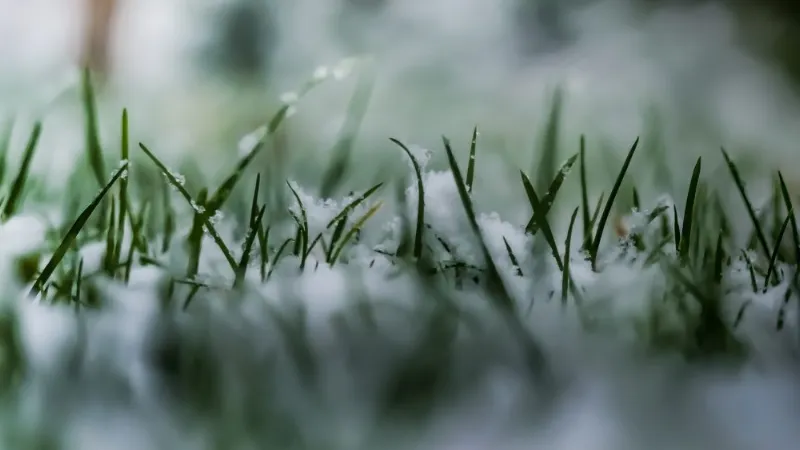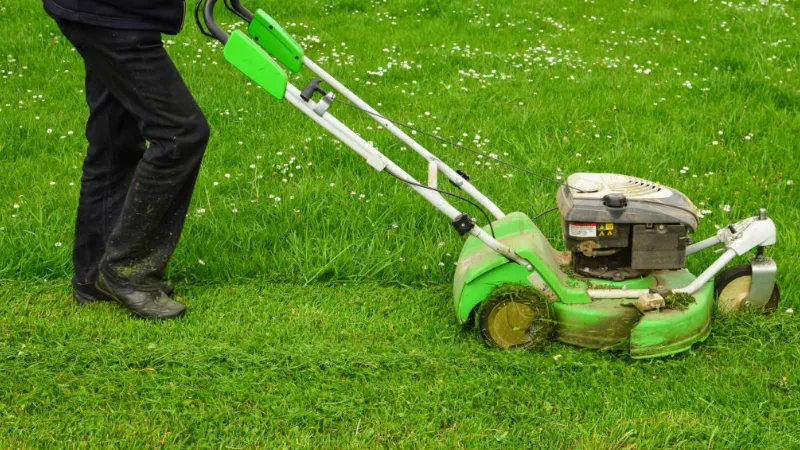Since grass seeds can endure the winter, it is possible to plant during the dormant season. So, can I sow grass seed in winter? How to sow grass seed in winter?
You need to make preparation, choose the right grass seed, sow, water, and wait. Please continue reading for more information.
How to Sow Grass Seed in Winter?
So it turns out that you can plant grass seed during the colder months, as we’ve already established. If you’ve decided that sowing grass seed in winter works for you, here’s how to go about it for the best results:
Preparation
Rake and level your lawn or soil before adding grass seed, just as you would at other times of the year. Check our full guide to growing a great lawn using grass seed for more details. If the ground is excessively wet, add a layer of topsoil and aerate thoroughly.
Choose the Right Grass Seed
For winter sowing, some grass seeds are better suited than others. As we mentioned before, we’d recommend our BS Winter Green Grass Seed containing high-quality and robust grass cultivars, but choose from our full range of lawn seed from mid-February onwards.

Sowing
Make sure to evenly distribute the seeds and that they make good contact with the soil. You can do this by rolling or treading the grass seeds in once it has been spread.
Watering
Water the area well if the ground isn’t already saturated. The moist soil should be maintained by the winter weather, negating the need for additional watering.
Wait
As your lawn reclaims its former beauty, sit back and relax.
Even though winter may not be the best season for sowing grass seed, you can definitely prepare the ground. Put in the effort during winter and when the temperature rises, your grass seed will be ready to grow into the lush lawn you were hoping for! But How Long Does Grass Seed Last?
Tips for Sowing Grass Seeds in Winter
- Choose a cool-season grass, such as fescues, Kentucky bluegrass, or perennial ryegrass, that germinates best when the ground is still slightly cool.
- Direct contact between seeds and bare soil is necessary.
- The best soil for dormant seeding is one that has been tilled or is loose.
- To agitate the soil and make sure it is clear of debris, rake the area before sowing the seeds.
- Follow seed provider guidelines for broadcast coverage. Equally as ineffective as under-seeding is using too much seed.
- After you’ve finished seeding, lightly rake the ground to cover the seeds.
- Stay off the grass and let nature handle the labor-intensive tasks. The cycle of freezing and thawing throughout the winter will help the seeds set. In addition, snowfall will evenly compress the soil, promoting germination.
- Herbicide application should be postponed until after germination has begun.
To develop your lawn maintenance strategy, learn how to identify crabgrass. Below will give you a full explanation of what is crabgrass.

Dormant Seeding
Similar to how it is done in the fall or early spring, grass seeding in winter is accomplished in a similar manner. Rake the seed into the soil after giving the area the best possible preparation. This technique works best if done at a time when snow will soon cover the ground and ideally before the ground is too frozen to work with. Snow will shield the seed and keep it in a dormant state if it is covered.
If the weather warms up during the winter, this approach could be dangerous. If the weather warms enough to melt the snow it may also warm up enough for the seeds to sprout. Seeds that have just sprouted are not hardy enough to endure the frost. Before trying to plant new seeds, the dead seedlings must be removed.
Even though dormant seeding carries some risk, it can avoid the need to sow in the early spring and wait for the ground to thaw. When the soil reaches a consistent temperature of 55 degrees, the seeds will begin to sprout because the soil will be fully nutrient-rich and will be the ideal environment for seed growth.
Where Dormant Seeding Works?
Planting grass seed in winter doesn’t work in all locations. A lawn that will soon be covered in snow and stays covered for the duration of the season is the ideal situation. Winter overseeding can be a challenge if you can’t achieve that consistency. Seed germination is impacted by the regular warming and cooling. They might start to grow too quickly and then perish in a cold spell.
How Cold is Too Cold for Grass Seed?
Regular grass seed may become too cold to grow if the soil temperature falls below 9 degrees. Just like any seed, grass seed needs the right conditions, with warmth and moisture being the keys to germination. The ideal soil temperature for grass seed germination is 9–12 degrees.
However, the great thing is, some grass seeds can grow below this, and our specially formulated Winter Green Grass Seed contains high-quality tetraploid perennial ryegrass that can germinate in soil temperatures as low as just 5 degrees. A successful, healthy growth or a less impressive outcome may depend on the selection of a suitable grass seed that can withstand winter temperatures. From the middle of February onwards, soil temperatures are generally warm enough to choose from our full range of lawn seed.
Can you mow wet grass? Short answer: No. Whether it’s early morning and the lawn is still dewy, a rainstorm just ended, or you just ran your sprinklers, you should skip the mow for now. Please read on for more detailed information.

Can I Sow Grass Seed in the Rain?
Whilst you can sow grass seed after a period of heavy rain, too much moisture may also hamper growth. Grass seed will have a better chance of germination if your soil drains well.
TOP TIP: If the ground is extremely wet, add topsoil and aerate your lawn to aid in the germination of your grass seed. Aeration is the process of creating holes in the soil with a fork or an aeration machine. This will loosen compacted soil and improve drainage.
How to Care for Your Lawn?
In order to maintain a lush, year-round growing lawn after the seeds have been planted, proper maintenance is required. A tried-and-true lawn care technique developed by Jonathan Green not only keeps weeds at bay and feeds the grass, but also aids in disease prevention.
You should feed the grass in the early spring to get it ready for the spring growing season and stop crabgrass before it starts. Green Up with Crabgrass Preventer can be applied to your lawn. This product not only treats any existing crabgrass but also helps prevent the growth of new crabgrass.
Late Spring is the perfect time to apply Green Up Weed and Feed. By doing this, you can get rid of any weeds that might be encroaching on your lawn and provide the grass with the nutrients it needs to grow throughout the summer.
In order to keep the pH of the soil at the ideal level for growing grass, it needs to be refreshed in the summer. There is MAG-I-CAL for pH that is either too low or too high. This unique formula quickly brings the pH of the soil to the proper range between 6.2. and 7.
The final treatment, Winter Survival, is administered in the fall. This will nourish your grass and aid it in fighting off any diseases during a harsh winter.

FAQs
Can You Plant Grass in February?
Studies have shown that February may be the best month for sowing a cool-season grass. A cool-season grass can be sown as early as February, according to studies. In areas with significant winter temperature variations, dormant seeding may not be effective.
How Long Can Grass Seed Lay Dormant?
A bag of grass seed is dormantly placed. Until particular requirements are met, such as being planted in the ground, the seed’s growth has been stopped. Dry grass seeds can survive for two to three years as long as they’re not exposed to moisture or extreme weather conditions.
How to Grow Grass Quickly in Winter?
- The planting should be timed when the ground is cold but not frozen. …
- In order for germination to occur, ensure that the seeds have good contact with the soil. …
- Don’t plant dormant seeds on dense grassy areas. …
- Lightly water the area, then leave it alone until spring.
How Can I Speed Up the Growth of Grass?
Fertilizing your lawn immediately after planting is one of the best ways to encourage rapid growth. Use Scotts® Turf Builder® Starter® Food for New Grass on all grass types to encourage growth that is up to 70% thicker and 35% more rapid (vs. unfed).
Summary: How to Sow Grass Seed in Winter?
How to sow grass seed in winter? You need to make preparation, choose the right grass seed, sow, water, and wait.
The act of sowing grass seed during the dormant season, or the winter, when the seeds are dormant, is known as dormant seeding. It’s a way to get a head start on growing a lush, green lawn in the spring if your patchy, straggly lawn needs some attention and you live somewhere where winters are consistently cold and snowy.
If you have any questions, please leave a comment. My Prime Home tries to give you the best home improvement information. Don’t forget to share the post. Thank you for reading.
Read about



